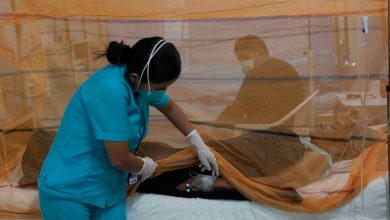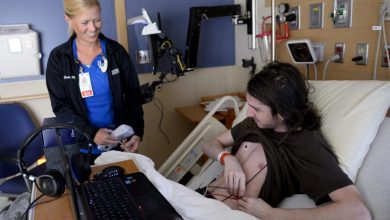I lost my mum, dad and baby sister to HIV in infected blood scandal

All Sam Rushby remembers about his family are fleeting memories of hospital corridors and waiting rooms.
In 1994, when he was only two years old, he lost his mother to AIDS. His father died of the disease a year later at Liverpool Royal Infirmary.
Her sister had also been infected with HIV, then a new, incurable virus, and died.
“My family was literally torn apart and ripped away from me,” he told BBC Panorama in his first ever interview.
“It’s like we got rid of it and it’s over now.”
Image source, Family photo
Sam’s father, Gary, was one of more than 1,200 people infected with HIV in the infected blood scandal, most after receiving a drug made from American blood plasma in the late 1970s and in the 1980s.
A long-running public inquiry into what has been called the worst treatment disaster in the history of the NHS is preparing to deliver its findings.
One of the main areas under scrutiny is whether authorities were too slow to act at the time.
Today BBC Panorama found that the British Embassy in Washington warned the British government of the risk of Aids from contaminated blood in the early 1980s.
An embassy official wrote a five-page memo to a senior Health Ministry official after meeting with a member of the U.S. AIDS task force.
The warning – one of several – came ten years before Sam was born.
Jim Reed meets with the families of some children with bleeding disorders and HIV infection to discuss their campaign for justice and what they hope for from the inquest.
It wasn’t until he was a teenager that Sam, now 32, began to learn the truth.
His father Gary was born with hemophilia, a genetic disorder that impairs the blood’s ability to clot. It almost always affects men, although women carry the hemophilia gene and can pass it on.
In the late 1970s, Gary began a new treatment intended to radically improve his life.
Factor VIII has been marketed as a miracle drug. Patients could simply take a bottle of white powder out of the refrigerator, mix it with distilled water, and inject themselves.
The bleeding would stop and, for the first time, hemophiliacs would be able to live more normal lives.
But these patients would later learn that entire batches of the new treatment had been contaminated with HIV and hepatitis C.
About two-thirds of people infected with HIV in the 1980s developed AIDS and died before modern antiretroviral drugs were available.
Sam struggled to understand the truth about what happened to his family when his grandparents finally told him.
“I didn’t believe it, I couldn’t believe it,” he said. “I can’t get over it, why does this have to happen?”
In the early 1980s, the UK was unable to meet demand for factor VIII, obtained by pooling – or mixing – blood plasma from thousands of individual donors.
Instead, the treatment was shipped from the United States.
In the UK, blood donations have always been voluntary, but in the US pharmaceutical companies were allowed to pay cash for plasma.
High-risk groups, from prisoners to drug addicts, had clear financial incentives to donate blood and potentially lie about their medical histories.
Evidence uncovered by campaigners and seen by the ongoing public inquiry into the wider tainted blood scandal shows that, as the risk of AIDS became known, a series of clear warnings were sent to the British government .
In May 1983, Dr Spence Galbraith, director of the UK’s Communicable Disease Surveillance Centre, wrote to Dr Ian Field, senior medical officer at the Department of Health, urging that all US blood products be withdrawn from use until there is a risk of AIDS has been “clarified”.
The letter from the British Embassy in Washington – which Panorama has now been able to view – was also sent to Dr Field, a month later, on June 28, 1983.
In it, an embassy official describes a meeting with a representative of the U.S. Centers for Disease Control’s AIDS task force.
The transmission of HIV through blood has been mentioned, he writes. Hemophiliacs were “most at risk” because of the “questionable habits” of some paid American blood donors and the mixing of thousands of these donations to produce factor VIII.
The group Tainted Blood, which represents hundreds of survivors and their families, says the letter shows a “staggering level of awareness and detail” of the dangers.
But this warning – and others – went unheeded. NHS patients continued to receive untreated factor VIII imported from the United States until at least 1985.
Many of the people involved in the decisions of the 1980s are no longer alive, including Dr Ian Field.
In 1983, knowledge about HIV and AIDS was still emerging.
At the time, a Health Ministry official called the call to withdraw US factor VIII premature and said it did not take into account the risks to hemophiliacs of removing a major source of their treatment.
Image source, Family photo
Sam says his father didn’t know he was infected with HIV for many years.
Gary unintentionally passed the virus to his wife Lesley. She later gave birth to a daughter, Abbey, who was born HIV positive and died at just four months old.
Lesley became pregnant again and in 1992 Sam arrived, this time testing negative for HIV.
But just two years later, Lesley died of an AIDS-related illness, followed a year later by her husband.
“The sad thing is I literally have no memory of it, just a handful of photos,” Sam says. “It’s this constant feeling of sadness, of wondering what growing up would have been like.”
Sam was raised by his grandparents, who initially told him that his parents had died of cancer and a stroke.
He didn’t begin to learn what really happened until his early teens, although the stigma surrounding AIDS forced him to keep the details secret because, he said, “teenagers could be mean.” .
“I’ve always suffered from anxiety and depression. If you lose your mom and dad at such a young age, it’s going to make you anxious,” he says.
“But then, later in life, I found out why and it only made the agony worse.”
Sam is one of hundreds of children to have lost their parents because of the scandal. To date, none have received compensation from the government.
In total, more than 30,000 NHS patients were infected with HIV and hepatitis C between 1970 and 1991 through contaminated blood products such as factors VIII and IX – or blood transfusions after surgery, a treatment or childbirth.
In other countries, from France to Japan, investigations into the medical disaster were completed many years ago. In some cases, criminal charges have been brought against doctors, politicians and other officials.
In the UK, campaigners say the scandal has never received more attention.
A private investigation in 2009, funded entirely by donations, had no real power, while a separate Scottish investigation in 2015 was branded a “whitewash” by victims and their families.
In 2017, following political pressure, then-Prime Minister Theresa May ordered a UK-wide public inquiry.
Headed by former High Court judge Sir Brian Langstaff, it had the power to compel witnesses to give evidence under oath and order the production of documents.
After a series of delays, its final report is now due on May 20.
Image source, Family photo
Research carried out as part of the survey found that 380 of the 1,250 patients with bleeding disorders infected with HIV were children at the time.
Many families also had to deal with the stigma of what was then an incurable disease.
Sarah-Jane’s younger brother, Colt, was infected with HIV and died aged 10 in 1992. She says the family, originally from Plymouth, had to move three times to try to escape the abuse of the inhabitants of the region.
“We were rejected, people talked about us. Colt had no friends because no one wanted to play with him,” she says.
“Friends and neighbors became distant, afraid and accusatory.”
In September 1985, a primary school in Hampshire made national headlines when the parents of a young haemophiliac told teachers that he had tested positive for HIV.
Other families pulled their children out of class and did not allow them to return until AIDS specialists were sent to properly explain the risks.
Image source, Family photo
The boy at the center of the media storm was only nine years old and anonymous at the time. But he can now be called Peter Adlam, 48.
“I just remember I didn’t want to be filmed by the cameras outside the school gates,” he told BBC Panorama in his first ever interview.
“I tried to blend in with the other kids as much as possible. As a kid, you should think that you’re indestructible and that you’re going to live forever and I was becoming very aware that that wasn’t the case.”
Peter then developed serious health problems related to HIV, including three bouts of pneumonia in 1996. At one point, his parents were told he may have only weeks to live.
New HIV drugs arrived in time to save his life, although he still faces many health problems to this day.
“Until that point, I didn’t think I’d see the year 2000. So it was very bleak and there wasn’t much hope,” he says.
“I saw other people my age living their lives and I couldn’t do it. I didn’t have a career, I didn’t travel. I can’t imagine what my life if I hadn’t been infected.
In August 2022, the government agreed to make the first ever interim compensation payments of £100,000 to around 4,000 survivors of the scandal or…
News Source : www.bbc.com
Gn Health





